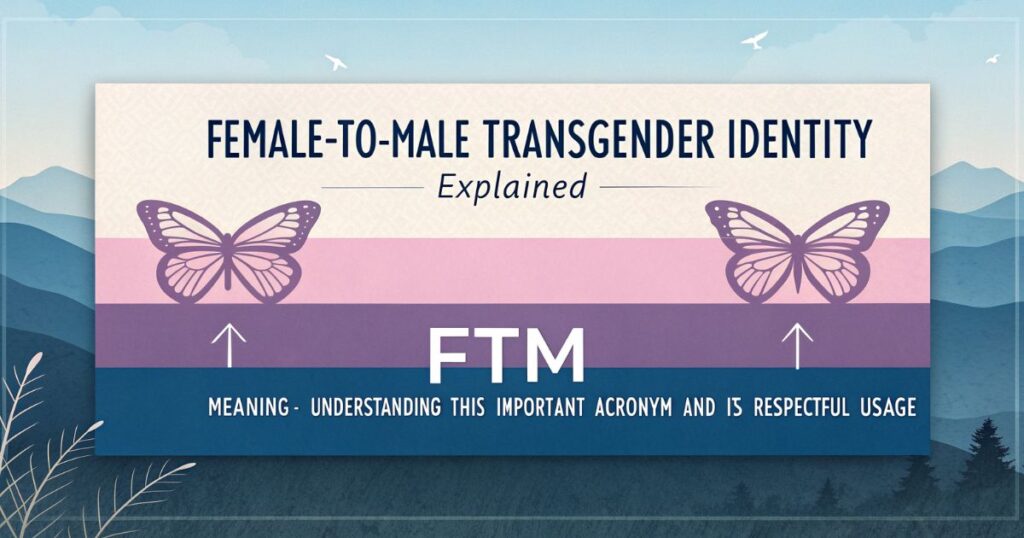FTM meaning has become increasingly important to understand in our evolving society.
This comprehensive guide explores the definition, proper usage, and respectful alternatives surrounding this significant terminology. You’ll discover everything needed to navigate conversations with confidence and consideration.
What Does FTM Stand For? Breaking Down the Core Definition
FTM primarily stands for “Female-to-Male” in transgender terminology. This acronym describes individuals assigned female at birth who identify as male.
The term represents a journey rather than just a label. When someone identifies as FTM, they’re expressing their authentic gender identity that differs from their birth assignment.
Medical professionals and LGBTQ+ organizations widely recognize this terminology. However, language continues evolving within transgender communities themselves.
Female-to-Male Transgender Identity Explained

Female-to-Male transgender individuals experience gender dysphoria – a disconnect between assigned sex and gender identity. This isn’t a choice but an intrinsic aspect of their being.
Statistics show approximately 0.6% of adults in the United States identify as transgender. Among these, roughly 30% identify as FTM transgender men.
The transition process varies significantly between individuals. Some pursue medical interventions like hormone therapy or surgery, while others focus on social transition through name changes and pronouns.
Research indicates that supportive environments dramatically improve mental health outcomes for FTM individuals. Acceptance reduces suicide risk by nearly 50%.
Alternative FTM Meanings You Might Encounter in Different Contexts
Beyond transgender terminology, FTM appears in various contexts with different meanings.
“First Time Mom” represents another common FTM abbreviation in parenting communities. New mothers often use this in online forums and support groups.
Business contexts sometimes use FTM for “Follow the Money” in financial discussions. Investment professionals occasionally employ this acronym.
Technical fields might reference “Fault Tolerant Machine” or “File Transfer Manager” using the same letters. Context determines the appropriate interpretation.
Why Understanding FTM Terminology Matters in Today’s Society
Inclusive language creates safer spaces for everyone. Understanding FTM meaning demonstrates respect for transgender individuals’ experiences.
Workplace diversity increasingly includes gender identity considerations. Companies implementing inclusive policies see 25% higher employee satisfaction rates.
Educational environments benefit from informed staff and students. Schools with comprehensive LGBTQ+ policies report fewer bullying incidents and improved academic outcomes.
Healthcare providers must understand these terms to deliver competent care. Medical professionals who use appropriate terminology build stronger patient relationships.
Common Misconceptions About FTM Identity That Need Clearing Up
Misconception: FTM individuals are “confused” about their gender.
Reality: Gender identity develops early in childhood and remains consistent throughout life for most people.
Misconception: All FTM people undergo the same medical procedures.
Reality: Transition paths vary dramatically based on personal needs, financial resources, and medical considerations.
Misconception: FTM is a “new trend” or “phase.”
Reality: Transgender individuals have existed throughout history across cultures. Documentation spans thousands of years.
Respectful Language: How to Use FTM Terms Appropriately in Conversation
Respectful communication starts with understanding preferred pronouns. Most FTM individuals use he/him pronouns, but always ask when uncertain.
Avoid outdated terms like “transsexual” or “sex change.” These phrases carry negative connotations and don’t reflect current understanding.
“Transgender man” or simply “man” often works better than “FTM” in casual conversation. The person’s identity matters more than their transition history.
Never ask about surgery or medical details unless you’re their healthcare provider. These questions invade privacy and reduce people to their anatomy.
FTM vs AFAB: Understanding the Distinction Between These Terms
AFAB stands for “Assigned Female at Birth” and represents a broader category. This includes FTM individuals but also encompasses non-binary people assigned female.
FTM specifically refers to people who identify as male. AFAB describes birth assignment without implying current gender identity.
Non-binary individuals might be AFAB but not FTM. They don’t identify as male despite their birth assignment.
Language precision matters in these discussions. Using correct terminology shows respect for diverse gender experiences.
Supporting FTM Individuals: Practical Ways to Show Respect and Allyship
Active allyship involves more than avoiding offensive language. True support requires ongoing education and advocacy.
Use correct names and pronouns consistently, even when the person isn’t present. This demonstrates genuine respect rather than performative behavior.
Advocate in your spaces – challenge transphobic comments and policies. Your voice carries weight in conversations where FTM individuals might feel unsafe speaking up.
Donate to organizations supporting transgender rights. Groups like the Trevor Project and GLAAD rely on community support for their vital work.
Medical and Legal Aspects: What FTM Transition Processes Involve
Medical transition options include hormone replacement therapy (HRT) with testosterone. This typically produces voice deepening, facial hair growth, and muscle development.
Surgical options vary from chest reconstruction (“top surgery”) to genital surgeries. Not all FTM individuals choose surgical interventions.
Legal transition involves changing names and gender markers on official documents. Requirements differ significantly between states and federal agencies.
Insurance coverage for transition-related care has expanded. Fifteen states now require insurance companies to cover transgender healthcare needs.
FTM Community Resources and Support Networks Across America
Online communities provide vital support for FTM individuals across the country. Platforms like Reddit and Discord host active support groups.
Local organizations offer in-person resources. Major cities typically have LGBTQ+ centers with specialized transgender programming.
Support groups help navigate transition challenges. Both FTM-specific and general transgender groups provide community connections.
Mental health resources specifically trained in transgender issues make significant differences. The World Professional Association for Transgender Health (WPATH) maintains provider directories.
Workplace Considerations: Creating Inclusive Environments for FTM Employees
Inclusive policies protect FTM employees from discrimination. Companies should explicitly include gender identity in their non-discrimination policies.
Bathroom access remains a practical concern. Gender-neutral restrooms provide safe options for all employees.
Name changes require systematic updates across company systems. HR departments should have clear procedures for supporting transitioning employees.
Training programs educate staff about appropriate behavior. Diversity initiatives that include transgender awareness reduce workplace harassment.
Educational Settings: How Schools Can Better Support FTM Students
School policies significantly impact FTM students’ academic success. Inclusive environments correlate with better attendance and graduation rates.
Pronoun usage in classrooms creates respectful learning environments. Teachers who use correct names and pronouns see improved student engagement.
Sports participation requires thoughtful policies. Individual assessment approaches work better than blanket restrictions.
Bathroom and locker room access needs careful consideration. Private facilities or inclusive policies help all students feel comfortable.
Family Dynamics: Navigating FTM Identity Within Family Relationships
Family support dramatically improves outcomes for FTM individuals. Accepting families reduce suicide risk by over 50%.
Coming out processes vary significantly. Some families adjust quickly, while others need time and education to understand.
Professional counseling helps families navigate these conversations. Family therapy specialized in LGBTQ+ issues provides valuable guidance.
Extended family challenges often require patience and ongoing education. Consistent messaging from immediate family members helps with broader acceptance.
Mental Health and Wellbeing: Understanding FTM-Specific Challenges and Solutions
Mental health disparities affect transgender populations disproportionately. FTM individuals face higher rates of depression and anxiety than cisgender populations.
Gender dysphoria creates significant psychological distress. Appropriate treatment including therapy and medical transition dramatically improves outcomes.
Minority stress from societal discrimination contributes to mental health challenges. Supportive communities help mitigate these effects.
Affirming therapy approaches focus on supporting authentic identity rather than changing it. Trained professionals understand transgender-specific mental health needs.
Legal Rights and Protections for FTM Individuals in the United States
Federal protections under Title VII now include gender identity discrimination. The Supreme Court’s Bostock decision expanded employment protections.
State laws vary significantly regarding transgender rights. Blue states typically offer broader protections than conservative regions.
Healthcare access receives protection under Section 1557 of the Affordable Care Act. Insurance discrimination based on transgender status is federally prohibited.
Education rights fall under Title IX protections. However, enforcement varies significantly between different presidential administrations.
FAQs
Q: Is it appropriate to ask someone if they’re FTM?
A: No, unless it’s medically relevant. Gender identity is personal information that people share when comfortable.
Q: What pronouns should I use for FTM individuals?
A: Typically he/him, but always ask. Pronouns are individual preferences that deserve respect.
Q: Can FTM individuals have biological children?
A: Yes, many can. Transition choices don’t eliminate all reproductive options.
Q: When did FTM terminology begin?
A: Modern usage emerged in the 1990s, though transgender identities have existed throughout history.
Moving Forward: Building a More Inclusive Society for All Gender Identities
Social progress requires ongoing commitment to understanding and inclusion. FTM individuals deserve the same rights and respect as all community members.
Education initiatives in schools and workplaces create lasting change. Inclusive policies benefit everyone by fostering acceptance and diversity.
Legislative advocacy continues pushing for comprehensive protections. Grassroots efforts combined with organizational support drive meaningful policy changes.
Conclusion
Understanding FTM meaning represents just the beginning of creating inclusive communities. Respectful language and supportive actions make real differences in people’s lives. Continue learning and advocating for equality in all your personal and professional spaces.
More Posts
Chisme Meaning: A Cultural Insight Into the World of Gossip
WTW Meaning: Complete Guide to the Acronym and Its Uses
Black Heart Meaning: Understanding Its Symbolism and Purpose

Welcome to Brightnis! I am the admin and creator of this platform. I love questioning ideas and exploring different situations. My goal is to encourage critical thinking and help people see things from new perspectives. Join me in discussing thought-provoking topics and finding unique solutions to everyday challenges!




![225+ Spicy Questions To Ask Your Crush [The Ultimate Collection] 225+ Spicy Questions To Ask Your Crush](https://brightnis.com/wp-content/uploads/2025/05/225-Spicy-Questions-To-Ask-Your-Crush-The-Ultimate-Collection-150x150.jpg)

